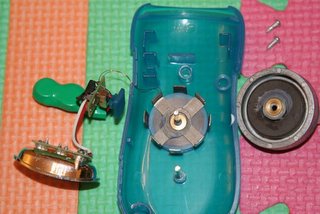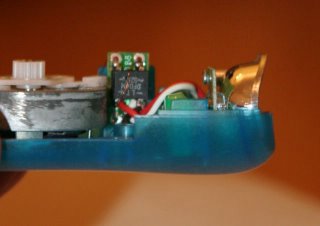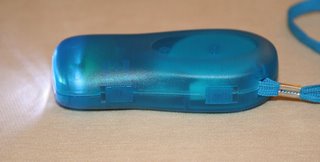No Batteries
 A flashlight that doesn't require batteries is nothing new, many of you have probably seen the early model
A flashlight that doesn't require batteries is nothing new, many of you have probably seen the early model  which involves shaking the flashlight to power it's lamp. However for those who have tried it, know it's not very practical in actual use.
which involves shaking the flashlight to power it's lamp. However for those who have tried it, know it's not very practical in actual use.Well I stumbled upon a slightly improved version that is powered by a simple palm squeezing action. This make charge-as-you-use quite practical (unlike shake action) plus it's quite compact (about palm sized), relatively bright (3 LEDs), holds a decent charge for short use, and is quite inexpensive (I paid USD$3.50).
In addition to being enviromentally friendly, you don't have to worry about the cost of replacement batteries, or the batteries going dead. As a bonus it even doubles as a grip excerciser, although the boxes claim of "improve the health" and "make your hands flexible" seem a little far stretched. I have the slight suspicion this packaging is not made for export to an English speaking country, afterall who would want to buy more "manual pressure", we already have enough other pressures in our everyday lives!


Let's have a look inside:
 Squeezing/pressing down on the lever turns a gear that drives the dynamo. The lever is spring loaded so that it pops back out after each squeeze. The dynamo, similar in principle to an electric motor but working in reverse, uses a spinning magnet's magnetic field to cut through a coil of wires inducing a current.
Squeezing/pressing down on the lever turns a gear that drives the dynamo. The lever is spring loaded so that it pops back out after each squeeze. The dynamo, similar in principle to an electric motor but working in reverse, uses a spinning magnet's magnetic field to cut through a coil of wires inducing a current. Here's a shot with the dynamo disassembled. The flywheel and magnet are on the right. Two very fine exposed copper wires run from the base of the dynamo to a switch. The windings of the copper wire can't be seen in this photo, but are located behind this base.
Here's a shot with the dynamo disassembled. The flywheel and magnet are on the right. Two very fine exposed copper wires run from the base of the dynamo to a switch. The windings of the copper wire can't be seen in this photo, but are located behind this base.
Soldered to the bottom of the switch is an IC labelled LT+ DF06M 5217. My guess is this is some sort of voltage/flow regulator circuitry inside. Oddly checking with a voltmeter, there is no measurable voltage at the input to this chip (coming from the two exposed copper wires of the dynamo),
but up to 3.8v can be measured from the output of this chip depending on how fast the dynamo is spinning.

With a degree in electrical engineering you think I would be able to easily understand and explain this, but alas no (too much time spent enjoying "other aspects" of college life) - I welcome anyone willing to offer some enlightenment. In the meantime moving on, one output of the switch is connected to a 3.6v 40mah rechargeable batter. That's not a lot of energy, but for low powered LEDs it gets by.

When turned on, the light will draw from the battery. Squeezing the lever will provide additional power directly to the light. Turning it off allows all power to be applied to charging the battery. Towards the back is an additional switch for locking the lever in it's down position keeping it compact.
 So how well does it work? Well after five minutes of squeezing (that's about how long before I tired out both hands), it runs pretty bright for up to a minute. After that it slowly becomes dimmer and will linger on for several hours although at that point it's not providing any useful illumination. The battery seems able to hold the charge for a while as well (it remained charged when I first took it out of the box, unless of course the store keeper squeezes them everyday).
So how well does it work? Well after five minutes of squeezing (that's about how long before I tired out both hands), it runs pretty bright for up to a minute. After that it slowly becomes dimmer and will linger on for several hours although at that point it's not providing any useful illumination. The battery seems able to hold the charge for a while as well (it remained charged when I first took it out of the box, unless of course the store keeper squeezes them everyday).The peak brightness (same as when it is being squeezed) lasts only around 10 seconds, after that it dims slightly. The only way to maintain peak brightness for longer periods is to keep pumping. With more practice it will be less tiring (and you will develop more muscular forearms and hands) and it's pretty easy to keep the light beam relatively still, but there is the dynamo whirring and lever squeezing sounds to deal with ruling it out for any stealth operations :)
Googling "self-generating flashlights" actually turned up quite a few sites selling beefed-up versions of this flashlight with a hand-crank dynamo, up to 5 LEDs, larger batteries, and even the ability to power another device or charge your cell phone. Of course the cost for such units are higher, running from $20 to $40.
Some interesting projects, Mark Hoestra turned one into an iPod charger and later also used a converted a bicylce dynamo.
Just a warning, the day before I bought a very similar flashlight with the same claims, but only when I opened it up did I discover that instead of rechargable batteries, it contained regular button cells found in watches. Some unscrupulous manufacturers will think of anyway to make an extra penny! I picked it up from a street stall, ok it was only $2.50 and had a working dynamo but still...

0 Comments:
Post a Comment
<< Home